Physical Address
Texas, U.S.A
Physical Address
Texas, U.S.A
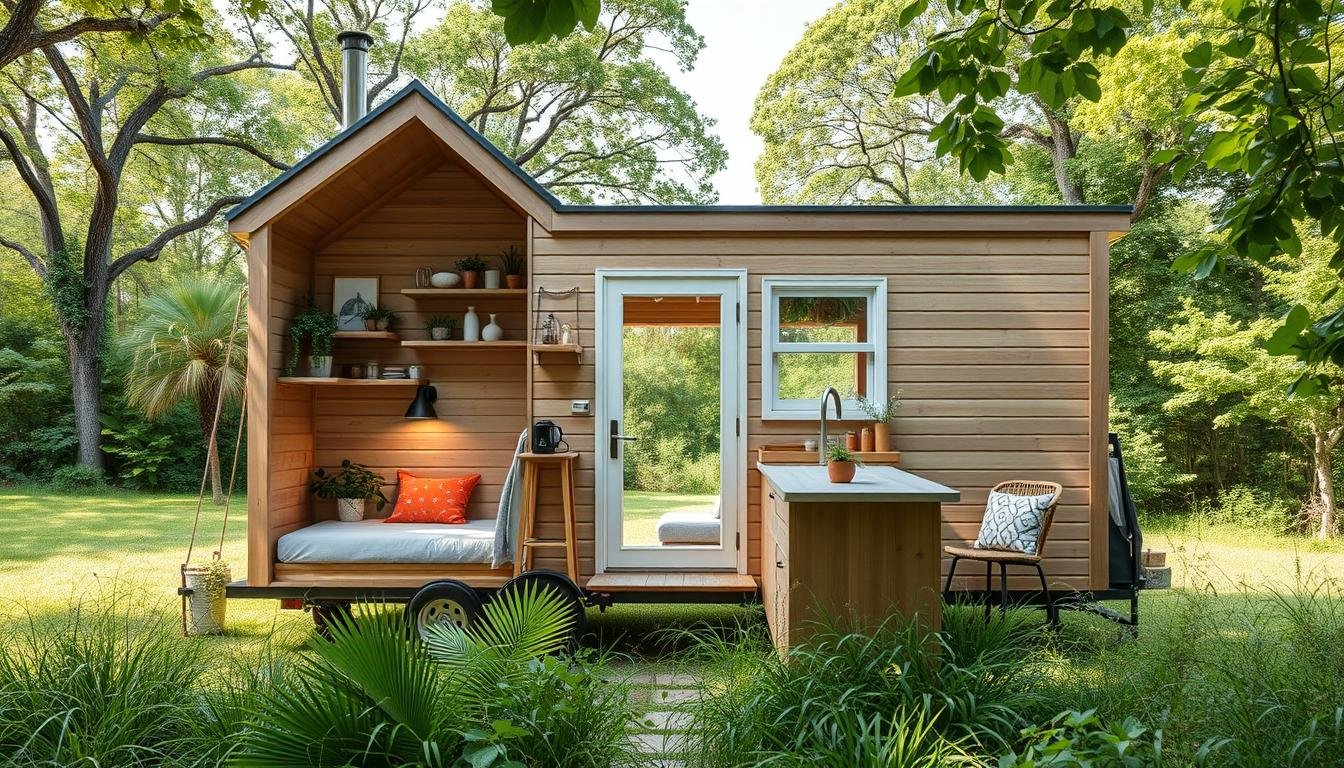
When I first visited my friend’s tiny home, I was struck by its coziness. The tiny house movement is growing fast in the U.S. It’s about downsizing and living simply in today’s busy world. Tiny homes, from 100 to 400 square feet, help us live sustainably and save money.
The tiny home market is set to grow to USD 4,171.33 million by 2027. This shows how popular tiny homes are becoming. You can choose from homes on wheels for travel, stationary homes for stability, or even converted vehicles for adventure.
Living tiny makes us think more about what we need and how to use our space well. We can use smart storage, multipurpose furniture, and vertical storage to make our homes work for us. Tiny homes also help us live greener and save on costs like housing and utilities.
The tiny house movement is growing fast. It attracts people who want a simpler, greener life. Tiny homes are small, ranging from 100 to 400 square feet. They encourage living with less, focusing on what’s truly important.
Living in a tiny home has many perks. The cost of a tiny house is between $20,000 and $100,000. This can mean living without a mortgage and enjoying more financial freedom.
Homeowners also save on property taxes, utility bills, and upkeep. This is because tiny homes are smaller.
Another plus is the simpler lifestyle it offers. Downsizing lets people focus on what really matters. They can spend more time on experiences and relationships, not just stuff. Plus, tiny home communities help people feel connected, boosting mental health and happiness.
One big reason to choose tiny house living is financial freedom. Downsizing can cut living costs, helping you save, pay off debt, and invest in your future.
Building or buying a tiny home is cheaper than a regular house. Prices range from $20,000 to $100,000. This means you can live without a mortgage, saving a lot each month. Tiny homes also use less energy, which lowers utility bills and helps the planet.
Minimalism is key to enjoying tiny home life. Choosing wisely what you own helps keep your space tidy and organized. This not only saves money but also brings peace and happiness. It lets tiny homeowners value experiences and relationships over stuff.
Starting your tiny home journey means picking the right home for you. You’ll find many options, from mobile homes to ones that stay put. It’s key to think about what you need and the laws in your area before you decide.
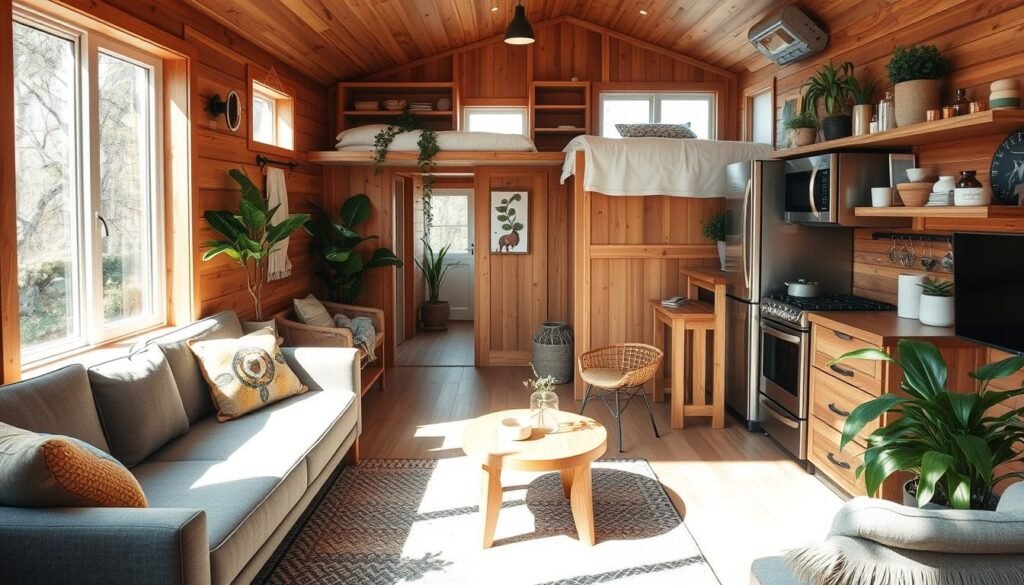
Looking at tiny homes, prices change a lot. They depend on where it is, how big it is, and what it has. Tiny homes are much smaller than regular houses, so you need to think carefully about how you use the space.
One big choice is whether to get a mobile home or a fixed one. Mobile homes let you move around and change places easily. But, they have to follow rules about size and weight. Fixed homes give you a place to stay and can be made just how you like them.
When picking a tiny home, think about a few important things:
Thinking about these will help make sure your home is cozy, useful, and saves energy.
Before you buy a tiny home, check the local laws and building codes. Laws can change a lot, and not following them can cause trouble. Here are some things to look into:
| Consideration | Importance |
|---|---|
| Zoning regulations | Determine whether tiny homes are permitted in your desired location |
| Building codes | Ensure your tiny home meets safety and structural standards |
| Minimum square footage requirements | Verify that your tiny home complies with local size regulations |
| Permanent foundation requirements | Determine if your tiny home needs to be secured to a foundation |
By looking into these legal things, you can avoid problems and make your tiny home move smooth.
Living in a tiny home changes how we see things. Downsizing and decluttering are key to minimalist living. By getting rid of what we don’t need, we make room for what’s important. This brings freedom and clarity.

The 90/90 rule is a good starting point for decluttering. If you haven’t used something in 90 days and won’t in the next 90, it’s time to go. This rule helps you see what’s not needed in your life.
The “One In, One Out” rule also helps. It means for every new thing you get, you must get rid of an old one. This keeps your space balanced and intentional.
When downsizing, focus on what’s essential. Look for furniture that does more than one thing. For example, beds with drawers or sofas that turn into beds. Also, having a small wardrobe with versatile clothes makes life easier.
When getting rid of items, think about how to do it right. Donate or sell things that still have life in them. This helps others and is good for the planet. For things that can’t be given away, recycling or professional removal services are options.
Keeping a tiny home tidy is a continuous effort. Check your belongings regularly to make sure they still bring you joy. By decluttering and living simply, you’ll find happiness and freedom in your tiny home.
Living in a tiny home doesn’t mean you have to give up comfort or style. With smart ideas and storage solutions, you can make the most of every inch. Create a cozy and inviting space that shows off your personality and meets your needs.
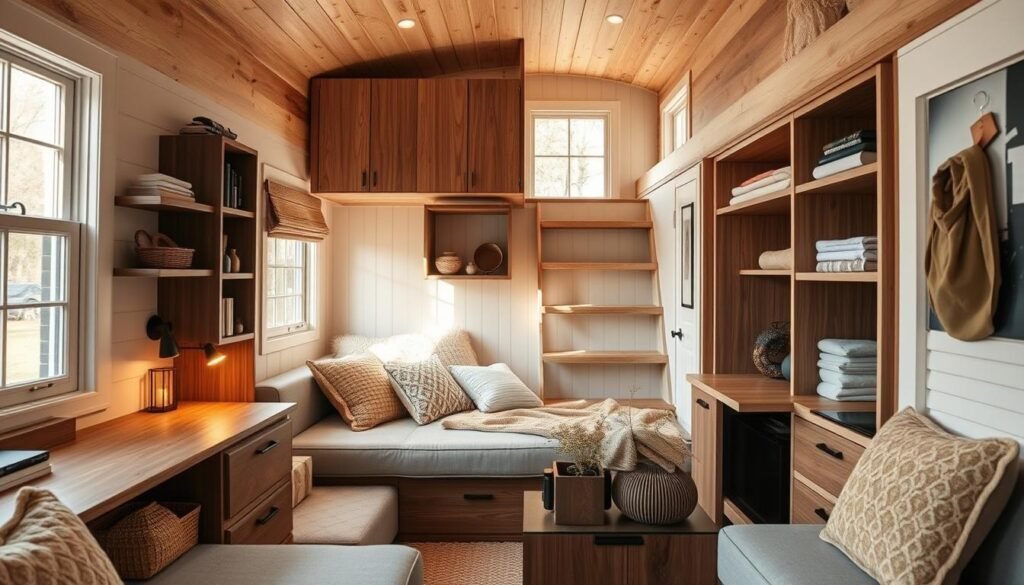
Storage is crucial in a tiny home. Use every corner with creative storage ideas. Install deep drawers for clothes and linens. Replace regular shelves with corner shelves for a space-saving option.
Turn your stairs into storage with drawers or cabinets. Use wall space for hanging pots and pans, and install skinny shelves for spices. Door organizers are great for small items.
Multipurpose furniture is essential when space is tight. Choose a sofa bed for guests. Pick a dining table that works as a workspace or add a bar top for extra space.
Poufs and ottomans with hidden storage are great for blankets and pillows. Nesting tables expand when needed and fold away when not in use.
Think vertically in a tiny home. Use wall space with shelving, hanging organizers, and pegboards. A blanket ladder adds storage and a cozy feel.
Use tension rods for extra hanging space in closets or under sinks. Don’t overlook your ceiling – hang a pot rack or a loft bed with storage.
The key to living comfortably in a tiny home is to be intentional about what you bring into the space and how you organize it. With a little creativity and some smart storage solutions, you can create a beautiful and functional home that fits your lifestyle.
Creating a cozy and efficient living area in a tiny home starts with the layout. An open floor plan and functional zones help make the most of every inch. This way, your tiny home feels both roomy and well-organized.
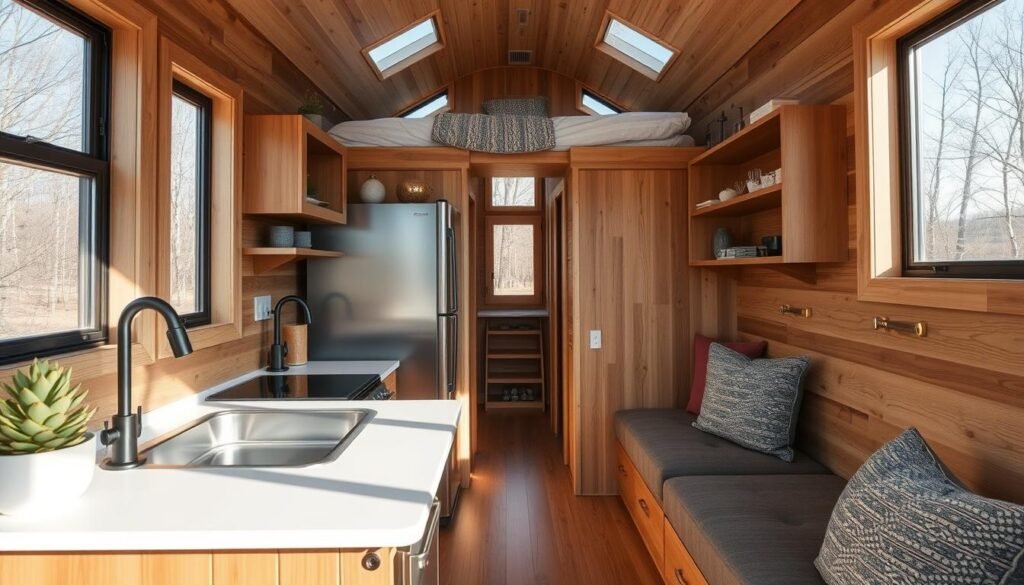
Designing a tiny home layout means embracing an open floor plan. Fewer walls and partitions make the space feel bigger. It also lets natural light move freely, improving both size and function.
When planning your open floor plan, consider these points:
| Design Element | Impact |
|---|---|
| Lofting the bed | Frees up valuable floor space |
| Mesh loft | Adds extra space without sacrificing light or airflow |
| Sliding doors | Save space and offer design flexibility |
| French doors | Establish a connection with outdoor spaces and let in more natural light |
To make your tiny home both efficient and cozy, create functional zones. Designate areas for sleeping, cooking, working, and relaxing. This keeps your space tidy and maximizes its use.
Here are tips for creating functional zones:
By planning your tiny home layout carefully, you can create a welcoming and functional space. Remember, the secret to successful tiny home living is using every inch wisely through smart design and space optimization.
Turning your cozy tiny home into a warm haven is all about natural light and calming colors. These elements help make your small space feel bigger and more peaceful.

Maximizing natural light is key to making your tiny home feel bigger. Big windows let sunlight in and connect you to the outdoors. Adding skylights or clerestory windows brings in light from above.
Reflective surfaces like mirrors can also brighten your cozy tiny home. They make it seem more open and light. Placing mirrors right can make your space feel larger and brighter.
The right calming color palette is crucial for a peaceful tiny home. Light colors like white, beige, and pastels reflect light and make your space airy. They make it feel more open and spacious.
“Color has the ability to transform a cramped space into an airy sanctuary. By choosing light, soothing shades, you can create a sense of tranquility and openness in your tiny home.”
While neutral colors are common, don’t shy away from adding color with accents. Soft blues and greens can calm your space. Warm yellows and oranges can make it cozy and inviting.
Living in a tiny house means learning to live smart in a small space. With creativity and planning, you can make the most of your space. Here are some efficient tiny living tips to help you live comfortably in a small home.
Using multi-functional furniture is key to tiny living. A sofa that turns into a bed, a dining table that folds into the wall, or a storage ottoman can save space. Choose furniture that also has hidden storage to keep things tidy.

Vertical storage is a great small space hack for tiny homes. Wall-mounted shelves, hanging racks, and ceiling storage can save floor space. In the bathroom, wall-mounted storage keeps toiletries and towels handy. Mounting your TV on the wall also saves space.
Choose compact, energy-saving appliances for compact living solutions. Mini-fridges, single-burner stovetops, and combo washer-dryers save space and cut costs. LED lights and low-flow fixtures also help save energy and water.
Don’t forget to use your outdoor space. A small deck or patio is perfect for dining, relaxing, or entertaining. It adds a sense of openness and connection to nature, even in a small home.
Every inch must be thoughtfully planned and utilized to create a comfortable living space in a tiny home.
By using these efficient tiny living tips, you can create a cozy and inviting home. Downsizing brings freedom and simplicity. Discover the joy of living big in a small space.
Tiny homes are more than a trend; they’re a choice for living sustainably. Downsizing our homes helps us reduce our environmental impact. Tiny homes need less material to build and maintain, making them better for the planet.
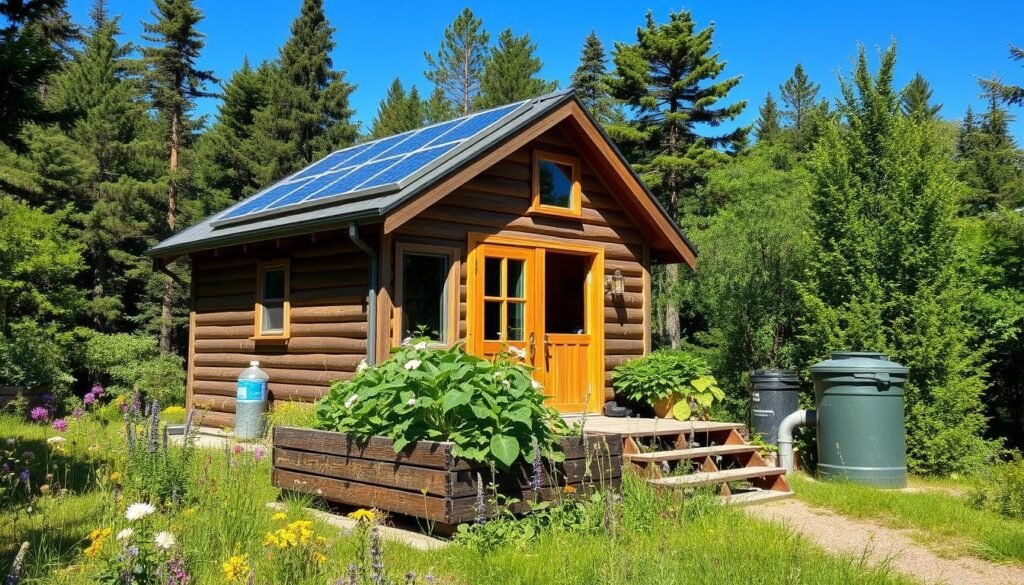
When building a tiny home, choose materials that are good for the planet. Using recycled and reclaimed materials can save money and the environment. Look for these items at reuse stores, auctions, and online marketplaces.
Using non-toxic materials for insulation and walls makes tiny homes healthier. These materials might cost more, but they’re better for the planet and our health.
Living off-grid is perfect for tiny homes. Solar panels and batteries can cut down energy costs. The initial cost is high, but it saves money in the long run.
| Eco-Friendly Practice | Benefits |
|---|---|
| Passive Solar Design | Significantly cuts down on electricity usage |
| Energy-Efficient Designs | Promotes sustainability and reduces environmental impact |
| Community Efforts | Enhances sustainability in neighborhoods |
| Renewable Energy Sources | Improves energy and resource management |
| Water Conservation Strategies | Leads to lower water consumption and decreased environmental impact |
| Waste Reduction and Recycling | Helps manage waste effectively |
Adding plants to tiny homes is good for looks and air quality. They help purify the air and can even grow food. This supports a sustainable lifestyle by cutting down grocery bills.
Composting toilets in tiny homes manage waste well. They break down waste into compost without bad smells. This compost is great for plants and gardens.
Living sustainably in tiny homes reduces our environmental impact. With smart choices, tiny homes can lead to a greener future.
Living in a tiny home is simpler and can save you a lot of money. When you plan your budget, think about the costs at first and the savings later. Downsizing can lead to big financial gains.

The price of a tiny home varies a lot. It can be from $4,000 to $140,000. This depends on size, where it’s located, and how much you do yourself. Tiny homes are usually between 100 and 400 square feet. Remember, almost half of renters spend too much on housing, making them cost-burdened.
Let’s look at the costs of building a tiny home. There are a few main areas to consider:
But, you can cut costs by doing DIY projects and using second-hand materials. Places like the Asheville Tool Library and MakerSpaces can help. They offer tools and advice for free or low cost.
Living in a tiny home saves money over time. You’ll pay less for utilities, insurance, and property taxes. This means big savings compared to regular houses.
There are many ways to finance your tiny home:
To save for your tiny home, track your spending and cut what you don’t need. Look into savings accounts with higher interest rates. Automatic transfers and using unexpected money for savings can speed up your goal.
Plan your tiny home budget well. Think about both the start-up costs and the long-term savings. Look at different financing options. This way, you can make your tiny home dream come true and enjoy the financial benefits.
Starting my tiny home journey, I found the joy of tiny house communities. These places across the U.S. connect people who love simple living. Being part of a village means sharing costs, saving money, and making friends.
Communities like Village Farm in East Austin, Texas, offer homes under $200,000. Rentals cost a few hundred to nearly $1,000 a month. This includes shared spaces like gardens and work areas. In Arizona, some places let you own your lot for just $200 a month.
But, tiny house living isn’t without its challenges. You might face zoning laws and criticism from others. Yet, the benefits are huge. I’ve found a new sense of purpose and belonging with my tiny home friends. Whether I stay in one place or travel, I know I have a community to come back to.